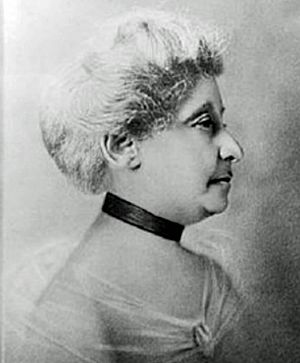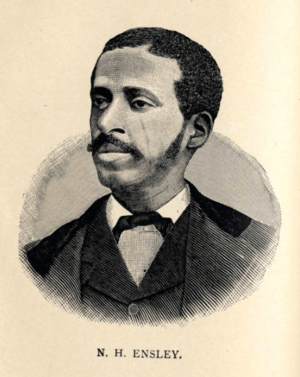Elizabeth Piper Ensley facts for kids
Quick facts for kids
Elizabeth Piper Ensley
|
|
|---|---|
 |
|
| Born |
Elizabeth Piper
January 19, 1847 |
| Died | February 23, 1919 (aged 72) Denver, Colorado, US
|
| Nationality | American |
| Known for | Women's suffrage |
| Spouse(s) | |
Elizabeth Piper Ensley (born January 19, 1847 – died February 23, 1919) was an important African-American woman. She was a teacher, a writer, and an activist. Elizabeth worked hard to help women get the right to vote. This effort is called the suffrage movement. She was born in New Bedford, Massachusetts and later became a leader in Colorado. She also started and led many women's clubs.
Contents
Elizabeth's Early Life and School
Elizabeth Piper Ensley was born in New Bedford, Massachusetts on January 19, 1847. Her father, Phillip F. Piper, was from Virginia. Her mother, Jane Gibson, was from Georgia.
In 1868, Elizabeth graduated from the West Newton English and Classical School. This school was also known as the Allen School. After graduating, she traveled to England and other parts of Europe. She returned to the United States in December 1870.
Her Family Life

Elizabeth married Newell Houston Ensley on September 4, 1882, in Boston. Newell was born in Nashville, Tennessee, in 1852. He was born into slavery. His grandfather hired a teacher to teach him to read and write.
After the Civil War, Newell worked hard and went to school. He became a teacher and wanted to be a preacher. He studied at Roger Williams University and Newton Theological Seminary. He taught at several universities, including Howard University and Alcorn State University. He often spoke about important topics like "The Rights of Women" and "The Rights of the Negro."
Elizabeth and Newell had three children:
- Roger (born 1883)
- Charlotte (born 1885)
- Jean (born and died in 1888)
The family lived in Washington, D.C., and then Mississippi. They moved to Denver, Colorado around 1887 or 1888. At that time, only about 2% of Denver's population was African-American. Newell died in Denver in 1888. Elizabeth continued to live in Denver with her two surviving children and her mother.
Elizabeth's Career
After returning from Europe, Elizabeth started a library in Boston. She also became a public school teacher in Trenton, New Jersey. From 1882 to 1883, she taught at Howard University. She also taught at Alcorn State University before moving to Denver.
In Denver, Elizabeth became a writer for The Woman's Era. This was a national newspaper for African-American women. It was published by the National Association of Colored Women's Clubs (NACWC). By 1894, she was reporting on elections where women could vote for the first time.
Her Activism and Fight for Rights
Elizabeth Ensley was a strong activist who worked for many important causes.
Helping Others in Need
In 1893, there was a big economic problem called the Silver Panic. Many miners lost their jobs, and families in Denver became poor and homeless. Elizabeth helped organize relief efforts for them. She contacted people she knew in Washington, D.C., and Boston to raise money to help those in need.
Fighting for Women's Right to Vote
In Colorado, women could vote in school board elections, but not in other elections. Elizabeth had seen women's suffrage groups in Boston. She joined the campaign to get women the right to vote in all elections in Colorado. This was put on the ballot in November 1893.
Elizabeth was the treasurer for the Colorado Non-Partisan Equal Suffrage Association. She helped raise money for the campaign. She also worked to convince African-American men to vote for women's voting rights. In November 1893, the law passed. Colorado became the second state to give women full voting rights!
After women gained the right to vote, Elizabeth helped them learn how to use it.
- She helped create the Colorado Colored Women's Republican Club. This club taught African-American women how to be informed voters.
- She started the Women's League in 1894. This group taught black women about voting and why it was important. It also explained the issues on the ballot.
Elizabeth was very dedicated to making sure everyone had equal rights.
Leading Women's Clubs
Elizabeth founded the Colorado Association of Colored Women's Clubs (CACW) in 1904. This group brought together eight different organizations across Colorado. The CACW ran community and educational programs, like the George Washington Carver Day Nursery. Elizabeth served as the second Vice President of the Colorado State Federation of Colored Women's Clubs. She gave a speech in 1906 called "Women and the Ballot." She was also the only African-American member on the board of the mostly white Colorado Federation of Women's Clubs.
Her Legacy
Elizabeth Piper Ensley passed away on February 23, 1919, in Denver. She is buried in the Ensley family plot at Riverside Cemetery in Denver, Colorado.
In 2020, Elizabeth Ensley was honored for her contributions. She was named an honoree of the National Women's History Alliance. She was also added to the Colorado Women's Hall of Fame. Her work helped shape the future for women and African-Americans in Colorado and beyond.

